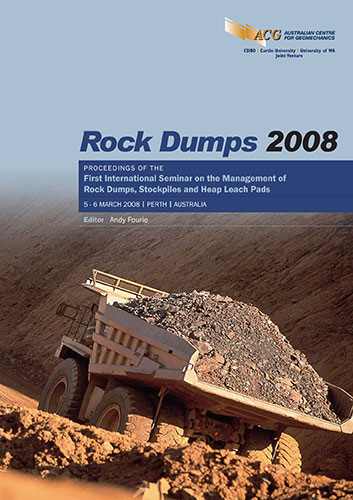Comparison of the Erosional Performance of Alterative Slope Geometries

|
Authors: McPhail, GI; Rye, C |
DOI https://doi.org/10.36487/ACG_repo/802_24
Cite As:
McPhail, GI & Rye, C 2008, 'Comparison of the Erosional Performance of Alterative Slope Geometries', in AB Fourie (ed.), Rock Dumps 2008: Proceedings of the First International Seminar on the Management of Rock Dumps, Stockpiles and Heap Leach Pads, Australian Centre for Geomechanics, Perth, pp. 277-288, https://doi.org/10.36487/ACG_repo/802_24
Abstract:
The principal criterion in specifying a dump or heap leach pad slope geometry is slope stability which requires that the overall slope of the facility be such that the facility remain stable under all reasonably conceivable conditions. However, long-term erosional performance is also an important criterion and one that frequently results in major construction costs to modify the slope geometry at closure. It is therefore prudent to consider erosional performance in the course of evaluating slope stability. The required geometry for long-term erosional performance has long been a concern of regulators who have been under pressure from industry to provide guidelines that, if complied with, will ensure that the closed facilities automatically satisfy relinquishment requirements without a need for detailed justification. To date, most guidelines have stipulated a slope geometry made up of a series of benches with slopes ranging from 18 degrees to natural angle of repose between the benches. However, observation of the performance of such benched slopes has shown poor performance generally related to silting up and overtopping of benches as well as severe gully erosion of the slope faces. This paper documents the evaluation of a range of slope geometries using the erosion model SIBERIA. The paper provides a quantitative comparison of their relative erosional performance and presents criteria and guidelines for the selection of a dump or heap leach pad slope geometry to meet erosional performance requirements.
References:
Cerda, A. and Doerr, S.H. (2005) Influence of vegetation on soil hydrology and erodibility following fire: an 11-year
investigation, International Journal of Wildland Fire, Vol. 14, No. 4, pp. 423-437.
Collins, S.M. (2002) Improving Rehabilitation Practices for the Outer Batter Slopes of Bauxite Residue Disposal Areas
at Worsley Refinery, Collie, Western Australia, Murdoch University, Western Australia.
Morgan, R.P.C. (1995) Soil Erosion & Conservation, Longman, London.
Rice, B. (2003) Hummock Grasslands in Australia, Macquarie University, New South Wales. Available from:
Rosewell, C.J. (1997) Potential sources of sediments and nutrients: sheet and rill erosion and phosphorus sources,
Australia: State of the Environment Technical Paper Series (Inland Waters), Department of the Environment,
Sport and Territories, Canberra.
Toy, T.J. and Foster, G.R. (1998) Guidelines for the Use of the Revised Universal Soil Loss Equation (RUSLE) Version
1.06 on Mined Lands, Construction Sites, and Reclaimed Lands, The Office of Technology Transfer, Denver.
Willgoose, G.R. (2005) User Manual for Siberia, Telluric Research, New South Wales.
Willgoose, G.R. and Riley, S.J. (1998) Application of a catchment evolution model to the prediction of long-term
erosion on the spoil heap at Ranger Uranium Mines: Initial analysis. Canberra, Australian Government
Publishing Service. Supervising Scientist Report 132.
Comparison of the Erosional Performance of Alterative Slope Geometries G.I. McPhail, C. Rye
288 Rock Dumps 2008, Perth, Australia
© Copyright 2025, Australian Centre for Geomechanics (ACG), The University of Western Australia. All rights reserved.
View copyright/legal information
Please direct any queries or error reports to repository-acg@uwa.edu.au
View copyright/legal information
Please direct any queries or error reports to repository-acg@uwa.edu.au